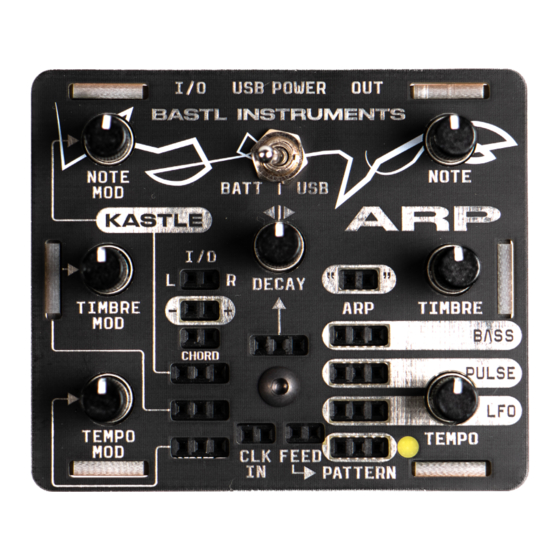
Advertisement
Quick Links
Advertisement

Subscribe to Our Youtube Channel
Summary of Contents for Bastl Kastle ARP
- Page 1 KASTLE BASTL INSTRUMENTS...
- Page 2 For maximum joy, try running your Kastle ARP through delay and reverb effects. By combining it with other Kastle synths, you can achieve unparalleled patch flexibility.
-
Page 3: What's In The Box
Instructions Kastle ARP is a mini modular synth, and like every modular synth, the sounds are programmed by connecting outputs to inputs. Outputs are labeled with a silver outline around the patch points, while inputs do not have the silver outline. - Page 4 0 POWER UP To start using the Kastle ARP, you will need either a micro USB cable or 3 AA batteries. If you have a cable, connect it to a powered 5V USB socket. If you’re using batteries, make sure to insert them into the battery compartment correctly, following the instructions on the battery holder.
- Page 5 The NOTE knob (located at the top right) selects the note to be played. By turning the knob, you can hear different notes. You can modulate the NOTE MOD input with an LFO, allowing the Kastle ARP to create melodies on its own. The NOTE MOD knob controls the amount of the modulation. Every time a note is changed, the envelope will be triggered.
- Page 6 DECAY However, the DECAY envelope is also a key factor in playing melodies on the Kastle ARP. Each time a note changes (either via NOTE or CHORD), the envelope is triggered. When the decay knob is turned to the left (CCW) of the 12 o’clock position, the envelope will only re-trigger once it falls below a ...
- Page 7 NOTE MOD: envelope notes played DECAY envelope notes played DECAY envelope notes played DECAY envelope notes played DECAY envelope notes played DECAY 7 This is the primary output from the oscillator that is audible at the OUT jack. This patch point can be utilized as an additional output for your patch, but it is particularly convenient for passively mixing the BASS output with the main oscillator.
- Page 8 The boot mode allows you to modify the root key and fine-tune the Kastle ARP. To access the boot mode, follow these steps: 1 Switch off the Kastle ARP. 2 Disconnect all patch cables. 3 Connect CHORD to the “+” patch point.
- Page 9 To exit the boot mode, disconnect the patch cable from the CHORD input. The ROOT and FINE-TUNE settings will be saved in the memory and loaded when the Kastle ARP is turned on again. THE LFO SECTION The Kastle synth features 2 ATtiny chips – each programmed independently.
- Page 10 TEMPO The TEMPO knob sets the speed of the modulation and affects all the LFO outputs (PATTERN, LFO, and PULSE). The LFO modulation is displayed by an LED close to the TEMPO knob. A modulation signal can be connected to the TEMPO MOD socket, while the TEMPO MOD knob sets the amount of the modulation.
- Page 11 CLK IN The CLK IN resets the phase of the TEMPO oscillator to the lowest point of the triangle, and then the triangle begins to rise. Additionally, it forces the PATTERN generator to advance to the subsequent step and resets the PULSE generator.
- Page 12 INPUT / OUTPUT The I/O CV port allows for the connection of up to two modulation/audio/ clock signals from the Kastle to external equipment, or the connection of any external signal for modulating the Kastle. The signals are outputted using a stereo jack, and the patch points “L” and “R” can be connected to either the Left or Right channel.
- Page 13 PATCH TIPS Random melody This patch employs the skipping of notes when the DECAY knob is positioned to the left of the center, allowing the LFO generator unrestricted freedom to modulate other elements. Feed the BASS output to both the CHORD and NOTE MOD inputs.
- Page 14 Modulation ramp To generate an ascending ramp shape on the LFO output, patch the PULSE output to the CLK IN input. Use the LFO output to modulate NOTE MOD and utilize the PATTERN output to modulate the CHORD, thereby achieving tonal variation. USB POWER NOTE NOTE...
- Page 15 Fluid tempo Patch PATTERN to the TEMPO MOD input and increase the TEMPO MOD knob to get varying lengths of the LFO shapes. Use the PATTERN and LFO outputs to modulate various parametres. Patch BASS to ARP to mix the signal into the main output. USB POWER NOTE NOTE...
- Page 16 Ratchet Patch the PULSE signal into the CLK IN to generate a ramp signal on the LFO output, and patch the LFO to both the TIMBRE MOD and NOTE MOD inputs. Adjust the DECAY knob to the left of the center and allow the TIMBRE modulation to iterate multiple times before modifying the pitch of the oscillator.
- Page 17 Syncing two Kastle synths To sync two Kastles, connect the I/O ports using a jack cable. Determine which Kastle will serve as the primary clock source (Kastle Drum in the image) and connect the CLK output to the “L” patch point of the I/O ...
- Page 18 Main Tester Juha Kivekäs Beta Testers David Žáček, Jirka Březina, John Dinger, Patrik Veltruský, Tomáš Niesner Management John Dinger Graphic design Anymade Studio The idea turned into reality thanks to everyone at Bastl Instruments and thanks to the immense support of our fans.
- Page 19 www.bastl-instruments.com...





Need help?
Do you have a question about the Kastle ARP and is the answer not in the manual?
Questions and answers